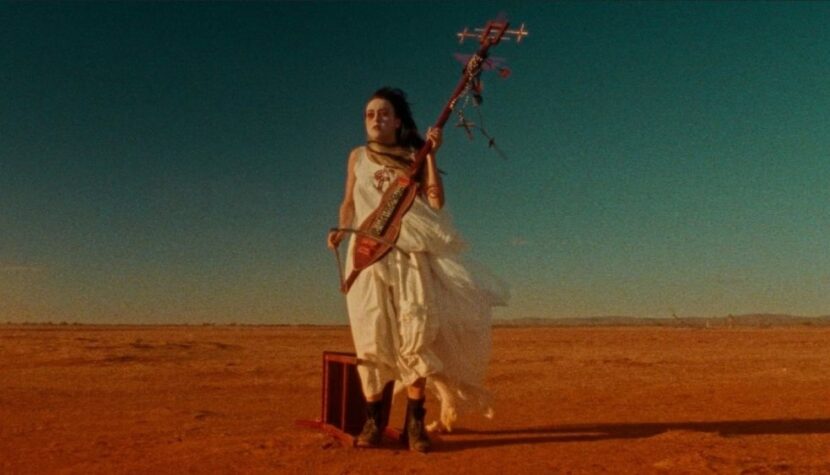“Spirits of the Air, Gremlins of the Clouds” is a poetic science fiction film from down under

Before he moved to Hollywood, where he directed, among others, “The Crow” (1994), “Dark City” (1998), and “I, Robot” (2004), Alex Proyas made an extraordinary debut with a film in his native Australia.
Felix and Betty Crabtree are eccentric siblings living in an old cottage somewhere on a vast, deserted plain. Confined to a wheelchair, Felix is an inventor obsessed with building a flying machine, and his previous attempts to soar into the skies have left him crippled. Betty, on the other hand, roams the area in elaborate dresses and intricate makeup, playing a strange instrument resembling futuristic violins and indulging in religious fanaticism. The peaceful existence of the siblings is interrupted by the appearance of a mysterious man chased by three hunters. The man, who introduces himself as “Smith,” is emaciated and conceals monstrous scars on his back. When he reveals that he is fleeing north, Felix informs him that a high cliff stands in the way, impossible to overcome on foot, and convinces Smith that the only way to bypass the obstacle is to build a glider. The men then begin working on the machine, but Betty, convinced that the newcomer is a demon from hell, does everything to get rid of Smith.

“Spirits of the Air, Gremlins of the Clouds” is the full-length debut of Alex Proyas, an Australian director of Greek-Egyptian descent who had previously made a handful of short films and music videos (including for INXS, Fad Gadget, and Yes). In 1986, Proyas embarked on the production of his post-apocalyptic science fiction screenplay, with half a million dollars, three actors, and a small technical crew at his disposal. Filming took place in the spring of that year at Supreme Studios in Sydney and on the Mundi Mundi plain near Broken Hill in New South Wales (where Mad Max 2 – The Road Warrior by George Miller was also filmed). Due to the limited budget, many sequences were created using practical effects, for example, the scene of bats flying against the backdrop of a full moon was shot in an illuminated aquarium with tea leaves floating in it. The first theatrical screening of “Spirits of the Air, Gremlins of the Clouds” took place in Sydney in 1987, but the film was not widely distributed until two years later, leading to conflicting release dates found on the internet.
The plot is not the strongest aspect of Proyas’s film, and the characters he created are either outlined too boldly, almost caricatured (Betty), or barely sketched (Smith). The narrative revolves around Felix and Smith’s successive attempts at flight, interrupted by the consumption of canned beans and Betty’s attempts to expel the enigmatic stranger. The viewer will never find out why Smith is fleeing and from whom; the film itself is so misty and symbolic that it can be interpreted as a story of fulfilling dreams in the face of lost hope, a parable about the clash of technology and religion, or even a metaphor for purgatory, in which the trio of heroes is trapped. The repetitive sequences of designing, assembling, and testing the glider contribute to the hypnotic rhythm of the whole, which slowly moves towards a predictable and therefore not very satisfying conclusion. Despite these criticisms, “Spirits of the Air, Gremlins of the Clouds” not only leaves a lasting impression but also captivates from the first minutes, refusing to let the viewer look away from the screen, quickly leading to admiration. How is this possible?

Well, it is a film so visually beautiful that any script deficiencies fade into the background. The meticulously designed set impresses: dark interiors of the cottage illuminated by candles, car wrecks embedded in the ground like totems of technocratic civilization, wooden gargoyles, flags fluttering in the wind, ubiquitous crucifixes and other religious items, rows of telegraph poles, the extensive landscape of red earth scorched by the sun after an unexplained disaster, azure sky, Felix’s workshop resembling the studio of a mad Leonardo da Vinci… All of this, together with Peter Miller’s wonderful music, makes a stunning impression, evoking a mixture of Tarkovsky, Burton, Gilliam, Leone, the paintings of Salvador Dalí, the graphic designs of the Hipgnosis studio, and the music video for Pink Floyd’s “High Hopes.” This unique, poetic film must have also impressed Emir Kusturica – his “Arizona Dream” almost replicates the main theme of “Spirits.” A film for artists, dreamers, and madmen.

